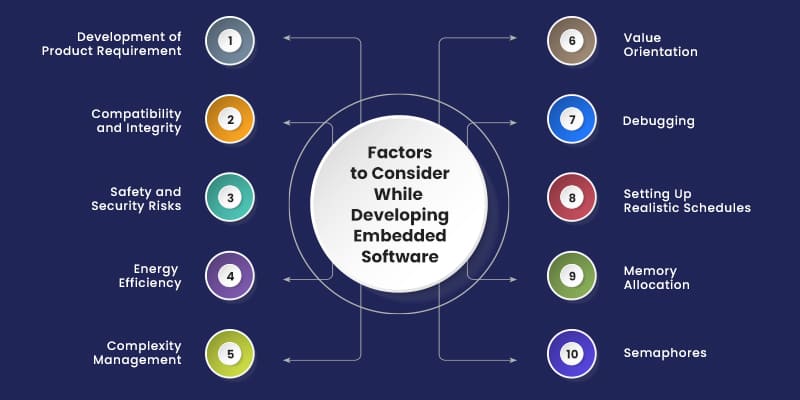
Embedded solutions are a vital part of enterprise software development. Driven by the need to innovate and provide more streamlined services and better results, these enterprise solutions are revolutionizing transportation, automotive, medical equipment, energy, communication, industrial automation, and many other industries.
Embedded software development is significantly different from traditional enterprise software development. The cost of developing an embedded solution is comparatively lower. Furthermore, these enterprise solutions have longer life spans and superior real-time performance and work seamlessly in heterogeneous environments.
Embedded software is loaded onto an embedded device, which can be anything from mechanical or biological systems to enterprise systems communication devices like actors, sensors, general purpose communication links, and specialized human interfaces. The wide range of computer peripherals like printers, monitors, flash memory sticks, etc, household appliances like digital TV, video cams, etc. and energy generation, distribution pacemakers, and automotive components like anti-lock brakes are all examples of embedded software.
What is Embedded Software development?
Embedded software is a piece of code that is embedded in the hardware or a non-PC device and uses operating systems or language platforms. Embedded software is usually tied to a device server as the OS itself within the specifications of the device so that additions and updates are seamlessly monitored. They execute many devices; aside from computers, embedded software runs on sound equipment, spacecraft, telecommunication switching systems, security system, pacemakers, weapons, heart monitors, climate control systems, and so on.
Furthermore, these enterprise solutions use microprocessors, microcontrollers, and other specific processing units that speed up active implementation, ranging from controlling to signaling processes. It requires encapsulating all required device drivers at the time of manufacturing which is written for specific and dedicated hardware by product engineering development teams.
Top 10 Factors to Consider While Developing Embedded Software

Whether you are fixing a car, remodeling a smart kitchen or developing embedded software, some significant factors always assist the whole process. Enterprise software development is a complex process. But developing embedded software is even trickier since there are many things to keep in mind while doing so. These enterprise solutions must provide real-time responses in all circumstances within specific designs and operate under limited memory, energy supply, and processing power. Furthermore, they must be immune to consistent changes in processors, hardware components, and sensors with portability and autonomy.
Therefore, it is imperative to consider the following factors while executing a product engineering development process for embedded software:
 Development of Product Requirements
Development of Product Requirements
Undoubtedly, the prime step in developing embedded software is to make sure that the software is device-oriented. Embedded software has to work with devices with limited resources so understanding the device and its limitations is essential before starting the enterprise software development process.
Product specifications are a document containing information about registers and their bit fields. For effective control, embedded software developers need to understand all intricacies with registers, memories, etc. of control elements. By ensuring proper register description with memory maps, all registers of the control element can be easily identified across the document by assigning a distinctive name.
Furthermore, they could be hot-linked so that they lead to a list that states the location, name, address, and block of each register. These specification documents also help embedded software developers describe each block’s functioning and how they should be approached. These documents guide the enterprise solution developers and create a framework for the evaluation of the project before the design identifies errors and bugs which saves time and money.
Read More: Top 10 Enterprise Software Development Solutions to Consider for Your Business
 Compatibility and Integrity
Compatibility and Integrity
Embedded software development requires timely implementation and software updates, especially regarding security concerns. But things get even more tricky due to the constant need for functionality expansion and software adaptability. During their development phase, these enterprise solutions require extreme compatibility to enable users to administer through a user interface by all available channels. So the fundamental needs are compatibility and integrity, which must not be compromised.
 Safety and Security Risks
Safety and Security Risks
Embedded software is much more vulnerable to hacks and security risks created by device malfunction than any other enterprise solution. It is vital that developers build hack-resistant embedded software using the latest technologies and enterprise software development security practices. Since embedded devices are connected to one another, a single compromised node brings the entire network down. So, every embedded software developer must employ defect prevention and removal activities. It is essential to achieve a high maturity process culture technique like model-driven development, disciplined traceability of requirements and changes, test-driven development, automatic testing, and code analysis should be considered.
 Energy Efficiency
Energy Efficiency
Efficient energy consumption is essential for embedded software. Since they operate on low-energy embedded devices, they must be very carefully designed to ensure optimum energy utilization. Embedded solutions should be independent of standard power supply with the use of capacitors and flash memories. The use of performance tools for the identification of idle processes & cache data to ignore bus & interface load is also a great idea.
 Complexity Management
Complexity Management
The consistent growth of the embedded software market has led to more complex enterprise solution development processes, with extra defects, costs, and the requirement to be measured and controlled. Using systematic processes internally and with suppliers to mitigate risks and for fast recuperation in other cases like insufficient performance is commonplace across various industries. The use of frameworks such as SPICE and CMMI is also becoming very popular these days. Both of them are designed for mixed hardware /software systems and assist in building a state of practice engineering environment. Additionally, developers should reduce code size and variants and apply model-driven design and tests to trace decisions of design.
 Value Orientation
Value Orientation
Unnecessary overhead like rework due to late defect detection and removal mounts up heavy cost for any product engineering development process which marginalizes the ideal state of software valuation. Developers need to apply the RACE (Reduce Accidents and Control Essence) principles, take a system perspective while a decision on software architecture, future evolution, and various interfaces. They should ensure consistency, traceability of decision and also specify the standard requirements so that respective marginal value can be tested.
 Debugging
Debugging
In today’s era of complex but high–performing applications with more numbers of connected devices, embedded projects cost more time and money. The system is usually interrupted by unexpected behaviors, resulting in more time spent debugging the applications. So to avoid this effort, enterprise solution developers must store and save memory and include multiple information windows for monitoring memory, the stack, and variables. Additionally, complex breakpoints make it possible to halt the execution of programs based on cycle counts, timer counts, or instruction counts.
 Setting Up Realistic Schedules
Setting Up Realistic Schedules
The stipulated time for embedded software development needs to be achieved through the successful completion of development and testing. Like any other product engineering development process, it is vital for project managers and developers to consult with each other and take all the complications that might arise into consideration before coming up with a realistic timeline for the project. It happens all too often that software development service providers overpromise and give customers outrageously small time windows. Due to such practices, developers work under a great deal of pressure to meet the deadline and end up creating and delivering the subpar products to the clients. So, it is always prudent to give a more realistic deadline to the clients while keeping a little time in the buffer for unforeseen circumstances.
 Memory Allocation
Memory Allocation
Memory Allocation is a crucial factor while developing embedded software. With the pressure on developers for performance and reliability and meeting the deadlines, memory storage allocation, organization, and data sharing must be paid proper consideration. Allocating the memory in two phases, where the large resources are allocated to the memory and then the smaller object in the second phase to reduce the memory failures.
 Semaphores
Semaphores
Semaphores are the software flags that are used to set the status of use for the resource in multi-tasking systems. The multitasking system can be very helpful during enterprise software development when there are common resources or shared resources. Effective data processing is the prerequisite for executing multiple tasks and direct access to the shared resources. The time–sharing mechanism uses a round robin where sometimes the resources are locked for the additional tasks and pre-empted for priority.
Reason to choose Matellio:
With years of experience engineering sophisticated software for embedded devices, Matellio has the talent and the tools to provide best-in-class software development services to various industries. We employ the latest embedded software development practices and norms to ensure maximum efficiency. Our enterprise software development experts are industry veterans with infallible instincts that they use to lead their projects to striking successes. We pride ourselves on building the solutions our clients want. That is why we take client feedback very seriously and also strive to meet their expectations.
To learn more about our embedded enterprise software development services, contact us!

 Development of Product Requirements
Development of Product Requirements Compatibility and Integrity
Compatibility and Integrity Safety and Security Risks
Safety and Security Risks Energy Efficiency
Energy Efficiency Complexity Management
Complexity Management  Value Orientation
Value Orientation Debugging
Debugging Setting Up Realistic Schedules
Setting Up Realistic Schedules Memory Allocation
Memory Allocation Semaphores
Semaphores


